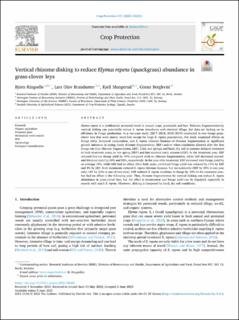| dc.description.abstract | Elymus repens is a problematic perennial weed in annual crops, grasslands and leys. Rhizome fragmentation by vertical disking can potentially reduce E. repens abundance with minimal tillage, but data are lacking on its efficiency in forage production. In a two-year study (2017–2018, 2018–2019) conducted in two forage grass-clover leys that were mostly weed-free except for large E. repens populations, this study examined effects on forage yield, botanical composition, and E. repens rhizome biomass of rhizome fragmentation at significant growth initiation in spring (early rhizome fragmentation, ERF) and/or when conditions allowed after the first forage cut (late rhizome fragmentation, LRF). Cold, wet springs and hard, dry soil in summer delayed treatment in both treatment years, to late spring (ERF) and late summer/early autumn (LRF). In the treatment year, ERF reduced first-cut forage yield by 44% compared with no rhizome fragmentation, while LRF decreased second- and third-cut yield by 24% and 53%, respectively. In the year after treatment, ERF increased total forage yield by on average 10%, while LRF had no effect. Over both years, combined forage yield was reduced by 11% by ERF and 4% by LRF. Both treatments reduced E. repens rhizome biomass, but inconsistently (ERF by 25% in one year only, LRF by 24% at one of two sites). ERF reduced E. repens incidence in forage by 10% in the treatment year, but had no effect in the following year. Thus, rhizome fragmentation by vertical disking can reduce E. repens abundance in grass-clover leys, but the effect is inconsistent and forage yield can be impaired, especially in swards with much E. repens. Moreover, disking is hampered by hard, dry soil conditions. | |
